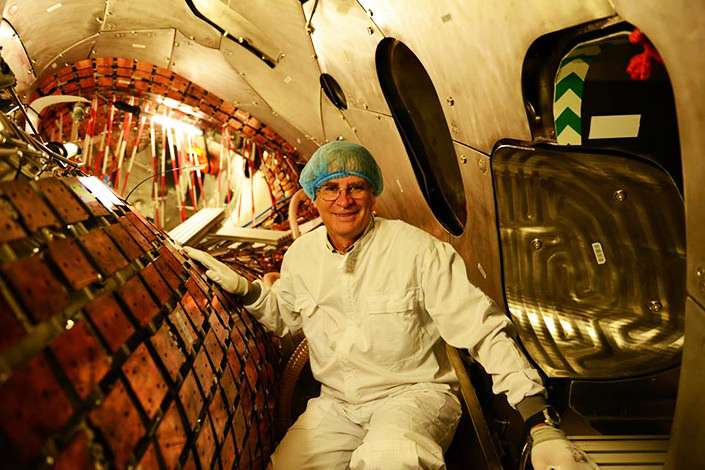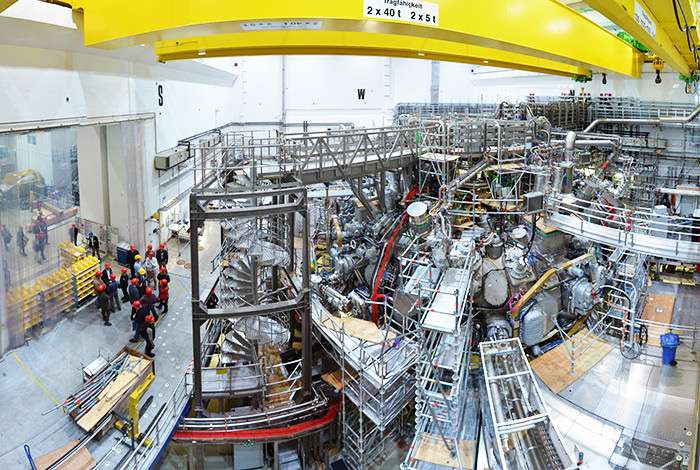Glen Wurden in the stellarator’s vacuum vessel during camera installation in 2014.
Since the world's largest superconducting magnetic fusion experiment, the Wendelstein 7-X stellarator, went online in December, innovative new imaging systems designed at Los Alamos National Laboratory are helping physicists peer into the roiling world of superhot plasmas as they test a promising alternative approach to harnessing fusion energy. The eventual result could be a plentiful source of clean and reliable power.
"This new stellarator uses optimized three-dimensional magnetic fields to enable continuous operation of high-performance, disruption-free deuterium plasmas," said Glen Wurden, of Los Alamos National Laboratory's Plasma Physics group. "The Los Alamos-designed diagnostic system plays an integral role in this collaboration and the studies of 3D magnetic field systems, especially pertaining to plasma boundary effects."
Within the stellarator, the magnetic fields contain the plasma, which is heated to 100 million degrees Celsius, at which point the deuterium—a heavy isotope of hydrogen—can fuse into helium and release tremendous, controlled energy.
The W7-X stellarator recently began operations at the Max Planck Institute for Plasma Physics in Greifswald, Germany, aided by researchers from several universities and institutes in the United States, including Wurden and John Dunn, also of the Los Alamos Plasma Physics group.
Preparations for the start of operations for this Department of Energy-sponsored, United States-German collaboration began four years ago, with a three-lab U.S. team consisting of Princeton Plasma Physics Laboratory (PPPL), Oak Ridge National Laboratory, and Los Alamos, which provided hardware, software and fusion researchers.
The Wendelstein 7-X stellarator required 19 years to go from initial design to operational status.
As the W7-X was under construction, Wurden developed and installed the imaging systems needed to study plasma edge effects and interactions with the armored walls in three-dimensional magnetic geometries within the machine. These systems are higher resolution than the German systems, which are designed to view the entire inner surface of the machine.
Wurden also provided an infrared camera that offered the highest resolution available and a visible imaging system on the same line of sight. Wurden and Dunn designed imaging systems for two phases of W7-X operation. In the first phase, a poloidal graphite limiter, which intercepts energy from the edge of the plasma, will be observed. In the second phase, the limiters will be removed, and the W7-X will study a newer technique to handle energy at the edge of the plasma by using magnetic island divertors. The Los Alamos imaging diagnostics will observe the divertor hardware and scraper elements as they control the plasma energy over a range of plasma pressures.
The stellarator is currently operating in a test phase using helium gas, but it will switch to hydrogen gas in February to begin more realistic experiments. Within the next three years, the W7-X is expected to demonstrate maintaining steady state, high-temperature deuterium plasmas for up to 30 minutes at a time, limited only by the project's electricity bill and the daily capacity of on-site water-cooling systems.
The DOE Office of Science's Office of Fusion Energy Sciences funded the work at Los Alamos. The research supports the Laboratory's Energy Security Mission and the Nuclear and Particle Futures science pillar by building the scientific foundation needed to develop a fusion energy source.
Provided by Los Alamos National Laboratory
























